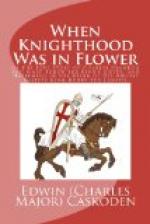The Play
The initial performance of the play was given in St. Louis on the evening of November 26, 1900, and the first New York production was on the fourteenth of the following January.
Its instant and continued success is well known. A prominent dramatic critic of the press has said:
“Julia Marlowe fully realized the popular idea of the Mary described by the novelist. She seemed to revel in the role. With its instantaneous changes from gay daring to anger and fear, from coyness to the dignity that hedges a princess, from resentment to ardent love, the part of Mary Tudor gives Julia Marlowe full scope for the display of her talent. She has never appeared to better or as good advantage as in this play for the reason that it gives opportunity for broader and more effective lights and shades than anything she has hitherto given us.”
When Knighthood Was in Flower
When Knighthood Was in Flower....
The Caskodens
We Caskodens take great pride in our ancestry. Some persons, I know, hold all that to be totally un-Solomonlike and the height of vanity, but they, usually, have no ancestors of whom to be proud. The man who does not know who his great-grandfather was, naturally enough would not care what he was. The Caskodens have pride of ancestry because they know both who and what.
Even admitting that it is vanity at all, it is an impersonal sort of failing, which, like the excessive love of country, leans virtueward; for the man who fears to disgrace his ancestors is certainly less likely to disgrace himself. Of course there are a great many excellent persons who can go no farther back than father and mother, who, doubtless, eat and drink and sleep as well, and love as happily, as if they could trace an unbroken lineage clear back to Adam or Noah, or somebody of that sort. Nevertheless, we Caskodens are proud of our ancestry, and expect to remain so to the end of the chapter, regardless of whom it pleases or displeases.
We have a right to be proud, for there is an unbroken male line from William the Conqueror down to the present time. In this lineal list are fourteen Barons—the title lapsed when Charles I fell—twelve Knights of the Garter and forty-seven Knights of the Bath and other orders. A Caskoden distinguished himself by gallant service under the Great Norman and was given rich English lands and a fair Saxon bride, albeit an unwilling one, as his reward. With this fair, unwilling Saxon bride and her long plait of yellow hair goes a very pretty, pathetic story, which I may tell you at some future time if you take kindly to this. A Caskoden was seneschal to William Rufus, and sat at the rich, half barbaric banquets in the first Great Hall. Still another was one of the doughty barons who wrested from John the Great Charter, England’s declaration of independence; another was high in the councils of Henry V. I have omitted one whom I should not fail to mention: Adjodika Caskoden, who was a member of the Dunce Parliament of Henry IV, so called because there were no lawyers in it.




